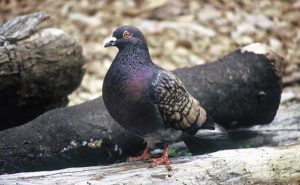
Photo: Lee Karney, US Fish and Wildlife Service, Bugwood.org
It has not escaped our attention that a variety of instances where birds are just being birds has been making the news lately. Take, for instance, the following:
- When male birds put in the work, happiness ensues: Inverse.com reports on a recent study published in the Proceedings of the National Academy of Sciences that set out to figure out whether the song, dance and plumage of many male birds really has an effect on mating success. Spoiler alert: While it makes more work on the female bird when they are trying to raise young together (a fact that any spouse of a showboating human can also attest to), the displays also surprisingly strengthened the male-female relationship and tended to increase the number of eggs she might lay the next time they mate. In other words, “happy wife, happy life” pertains to feathered friends, too.
- Plane lands safely despite bird attack: In August, The Insider reported that an Ural Airlines flight carrying 232 passengers took off from Moscow, Russia. Two minutes later, during its initial climb, it made an emergency landing in a cornfield after “it struck a flock of birds causing both engines to fail.” Only minor injuries occurred, and The Insider article links to several photos and videos of the event. The Aviation Herald, meanwhile, reports on it from a more technical standpoint. It notes that the plane hit a flock of seagulls (not to be mistaken for this Flock, and yes, we’re only being glib because no one was seriously injured in the frightening event).
- Pigeons keep bob, bob, bobbing along: We’ve all seen “winged rats” bob their heads as they strut all over local parks and parking lots — and if you haven’t, well, just imagine Mick Jagger in his prime. And it’s not just pigeons, but chickens, storks, cranes, herons and other, usually ground-feeding birds. As you might surmise, it’s less about being cool and more about stabilizing the bird’s vision as it moves. As LiveScience reports, “What we see as a ‘bob’ is actually the head sliding smoothly forward and then waiting for the body to catch up. We perceive it as a bob because the motion unfolds so rapidly.”
- Birds are gray squirrels’ canary in a coal mine: Research has shown time and again that animals pay attention to the alarm calls of other animals, but a new study in the online journal PLOS ONE finds that squirrels in particular are attuned to what the birds are twittering on about. According to coverage from NPR, “researchers have found that a squirrel becomes incredibly vigilant when it hears the shriek of a red-tailed hawk, but it will relax and resume its food-seeking behavior more quickly if the predator’s call is immediately followed by the easygoing tweets of unconcerned birds.” That said, pity the poor researcher student riding a bicycle around Ohio’s Oberlin College campus in January, jumping off to hide in the bushes with her audio equipment whenever she encountered an eastern gray squirrel to mess with its daily activities.
Whether all this newly discovered information will aid bird control professionals as they continue to find new and effective ways to deter pest populations remains to be seen. But now it’s your turn: What offbeat behavior have you encountered at bird accounts? How do you predict the industry can harness bird calls to squirrel-proof attics and roofs? Sound off below, or drop us a line at pmpeditor@northcoastmedia.net.
Leave A Comment